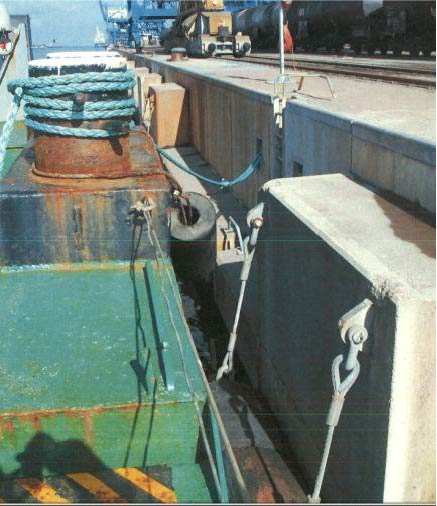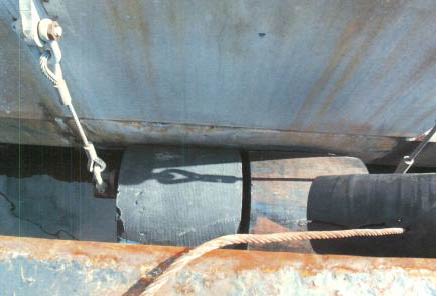Lost time injury (LTI): Fall overboard/fall from height
A member has reported an incident which a member of the crew of a hopper barge fell overboard onto a cylinder fender attached to the quay wall. He sustained serious injuries to his spine (twelfth thoracic vertebrae crushed and splintered). The incident occurred whilst alongside, during refitting a rope connection between the hopper barge and the quay wall. At the time of the accident the empty hopper barge was firmly moored at the quay wall, at one of the berths.
Due to adverse weather conditions (wind force 9, rain showers and swells in the inner harbour) and rising tide, the head line became slack. The injured person was on the foredeck to check the rope connection and to refit the rope. During refitting of the rope he had to bend slightly with his upper body overboard. When re-fixing the head line, the barge struck the berth fenders due to the wave motion in the harbour basin. As a result of this the injured person lost his balance and fell from a height of about 2m overboard onto the cylinder fender on the quay wall. He was rescued, using a ladder from the berth-fender and brought on board for transfer to hospital.



Our member identified the following causes to the incident:
- The injured person was working alone;
- He found it necessary to lean overboard and used no personal protective equipment (PPE) or restraint mechanism;
- There was a mechanical jolt of barge against quay wall fender;
- The relatively high position of the bollard and the low position of the top hand rail;
- Poor weather conditions;
- The working conditions and the weather conditions had not been properly risk assessed.
The following lessons were identified:
- Never lean out overboard without first securing yourself – everyone is responsible for their own safety;
- In poor weather conditions always work on deck in pairs and secure yourself to the deck;
- Crew need to remain aware that they can ‘Stop the job’ no matter who they are;
- Increase due care level for ‘routine’ jobs – be better informed about risk and control measures;
- As far as practical, use a capstan head or mooring winch to affix mooring lines;
- Improve the relatively high position of the bollard and the low position of the top hand rail;
- In case of suspected spinal injury do not move the injured person unnecessarily.
In 2013, falls from height formed 10% of recorded LTIs amongst IMCA member’s. There were clear lessons to reiterate to all members’ vessel management and crews with regard to:
- the correct use of fall restraint;
- full and proper risk assessment;
- ensuring a safe system of work.
In this case, attention is drawn to two incidents highlighting the risks of working alone:
- Lost time injury (LTI): Crush injury – arm trapped by movement of crane block
- Lost time injury (LTI): Crewman injured foot during offshore renewables mooring operation
Members should be aware of the following safety promotional materials:
- Working at height (pocket card)
- Workplace safety self-assessment (pocket card)
- Mooring safety (poster)
Safety Event
Published: 31 October 2014
Download: IMCA SF 17/14
IMCA Safety Flashes
Submit a Report
IMCA Safety Flashes summarise key safety matters and incidents, allowing lessons to be more easily learnt for the benefit of all. The effectiveness of the IMCA Safety Flash system depends on Members sharing information and so avoiding repeat incidents. Please consider adding safetyreports@imca-int.com to your internal distribution list for safety alerts or manually submitting information on incidents you consider may be relevant. All information is anonymised or sanitised, as appropriate.
IMCA’s store terms and conditions (https://www.imca-int.com/legal-notices/terms/) apply to all downloads from IMCA’s website, including this document.
IMCA makes every effort to ensure the accuracy and reliability of the data contained in the documents it publishes, but IMCA shall not be liable for any guidance and/or recommendation and/or statement herein contained. The information contained in this document does not fulfil or replace any individual’s or Member's legal, regulatory or other duties or obligations in respect of their operations. Individuals and Members remain solely responsible for the safe, lawful and proper conduct of their operations.
